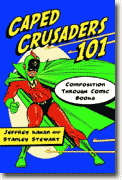Caped Crusaders 101
Jeffrey Kahan & Stanley Stewart
book reviews:
· general fiction
· chick lit/romance
· sci-fi/fantasy
· graphic novels
· nonfiction
· audio books
· author interviews
· children's books @
curledupkids.com
· DVD reviews @
curledupdvd.com
newsletter
win books
buy online
links
home
for authors
& publishers
for reviewers

 |
Caped Crusaders 101: Composition through Comic Books Jeffrey Kahan & Stanley Stewart McFarland & Company Paperback 208 pages January 2006 |
|
Few non-comic book fans would consider the idea that comic books, particularly characters, teams and on-going series, harvest any kind of subtext, represent deeper metaphors, or even challenge or reinforce abstract theories or ideologies. Jeffrey Kahan and Stanley Stewart set out to prove them wrong. Concentrating on the big publishers Marvel Comics and DC Comics, with Marvel getting the lion’s share of analysis, these authors provide seven in-depth case studies of comic books on topics such as racism, war, religion, sexuality, terrorism, and corporate responsibility.
The book’s versatility allows it to serve simply as a book to any comic book fan but also as a viable text for a literature or pop-culture college class. At the end of every chapter, the authors provide a section called “Thinking, Debating, Writing,” in which they list engaging questions and projects for students to consider. To add to the academic aspect of this book, the authors have also included relevant footnotes to back up their claims. These footnotes don’t reference only comic books, but also related books, journal and magazine articles as well as websites. And, as in any good academic tome, the authors intersperse their text with panels, pictures, and covers from the various comic books they discuss. While not all the chapters will grab the reader’s attention, the text proves easy enough that one can skim material that may not be entirely interesting or relevant. It might be argued that Kahan and Stewart are reading too deeply into comic books and the super-heroes that dominate each panel, but not by this reviewer. Their consideration and deconstruction of comic books fits quite aptly with recent examinations of pop culture in academia. Their argument weakens in their claims of how influential the comic books themselves are on children and teenagers. The numbers they offer (over 20 million for Marvel Comics and nearly 15 million for DC Comics in monthly distribution, for children ages 6-11) are not thoroughly explored. Does this mean that Marvel sells comics to over 20 million children in that age range or (and much more likely) 20 million comic books in total are bought by children in this bracket? If that’s the case, the influence dwindles greatly. Given that an avid reader will read or collect anywhere from five to twenty comics a month, this would drastically reduce the numbers they imply. Their math gets even trickier as they imply that most comic books ultimately pass through four or five people’s hands. These numbers are dubious; the quote for monthly comic sales comes from 2002, while the projection of four to five readers per individual comic book comes from a Master’s Thesis in 1979—well before the 1980s and 1990s craze to save and preserve each and every single comic book in one’s possession. While their enthusiasm is appreciated, their sloppy work in this regard is a little disappointing. Despite this, Kahan and Stewart have crafted an amazing piece of analysis on comic books that explores the deeper reaches of the human (and superhuman) psyche, allowing readers to access a great range of understanding when they flip open their comic books. Rather than have the last word, they recognize that there are many other ways and levels to interpret these stories and merely provide readers with new skills to do so. Originally published on Curled Up With A Good Book at www.curledup.com. © Lance Eaton, 2006 |
|
|
|
 Click here to learn more about this month's sponsor! |
|
| fiction · sf/f · comic books · nonfiction · audio newsletter · free book contest · buy books online review index · links · · authors & publishers reviewers |
|
| site by ELBO Computing Resources, Inc. | |
 Kahan and Stewart know their material and how to decode comic books on several levels, from what goes on in each panel to how characters embody particular philosophies to exploring the importance of the mythos character origins. Whether considering the Hulk’s repressed sexuality or the Christian imagery and theology of the Daredevil, this book packs numerous examples to back up the authors’ claims and draws on a wealth of comic book history, from Action Comics #1 in 1937 all the way to theatrical and literary releases in 2005. Another strong point of the book is its willingness to explore and incorporate different forms of comic books such as radio dramas, television shows, movies, and merchandising.
Kahan and Stewart know their material and how to decode comic books on several levels, from what goes on in each panel to how characters embody particular philosophies to exploring the importance of the mythos character origins. Whether considering the Hulk’s repressed sexuality or the Christian imagery and theology of the Daredevil, this book packs numerous examples to back up the authors’ claims and draws on a wealth of comic book history, from Action Comics #1 in 1937 all the way to theatrical and literary releases in 2005. Another strong point of the book is its willingness to explore and incorporate different forms of comic books such as radio dramas, television shows, movies, and merchandising.